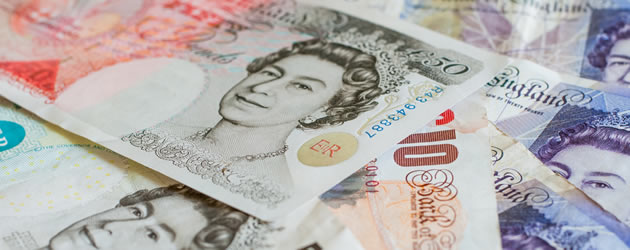- ECB less dovish than anticipated at July policy meeting – Euro nevertheless weakened on prospect of imminent easing
- US Dollar trended lower thanks to mixed domestic data – Concerns continued to mount over outlook of world’s largest economy
- UK PMIs for July point to sharp contraction in growth – Pound slumped as Brexit shock shown to have damaged economy
- Weak US data could boost GBP USD exchange rate ahead of weekend – Odds of Fed interest rate hike remained in flux
Sterling sentiment took a severe blow on Friday morning thanks to discouraging post-Brexit ecostats, weakening the GBP EUR and GBP USD exchange rates.
Pound (GBP) Weighed Down by Weaker-than-Expected UK PMIs
Confidence in the Pound (GBP) was dented on Thursday, with the optimism of the unexpected dip in the ILO Unemployment Rate wearing off. Markets were discouraged by the June Retail Sales figures, as consumer spending was revealed to have been weaker than expected in the run-up to the EU referendum. Sales softened from 5.2% to 3.9% on the year, suggesting that sentiment had turned bearish due to the uncertainty surrounding the vote. This dip was considered particularly concerning as the majority of the data was compiled before the shock result was known, seeming not to bode particularly well for the health of the economy in the wake of the decision to Brexit.
Friday morning saw another sharp slump in Sterling, thanks to the raft of flash UK PMIs for July. Forecasts had pointed towards a significant contraction in growth across the board as a result of the Brexit vote. However, investors were surprised to find that the service sector had in fact suffered a greater decline than anticipated, clocking in at 47.7 rather than 48.7. Altogether the results indicated that the domestic economy is contracting at its fastest pace since the financial crisis, denting investor confidence. As a result the Pound returned to a bearish run, ceding its recent gains back to rivals.
Sufficiently Dovish ECB Commentary Boosted GBP EUR Exchange Rate
Unsurprisingly, the European Central Bank (ECB) opted to make no change to its monetary policy at its first post-Brexit meeting. However, while interest rates remained on hold for another month the appeal of the Euro (EUR) weakened in the wake of the announcement. Although President Mario Draghi failed to offer any particular hints as to whether policymakers are likely to consider a move in September this did not prevent the single currency from trending lower. As Derek Halpenny, European Head of GMR, noted:
‘President Draghi was willing to offer his view that it didn’t seem like Brexit had had any big impact on inflation. That certainly suggests no dramatic changes to the stance of the ECB going forward. But even a modest shift lower in inflation projections and risks would imply that the current stance of ending QE in March 2017 is not consistent with their policy objectives.’
Downside pressure continued to drag on the single currency on Friday morning, in spite of some rather encouraging Eurozone PMIs. This seemed to confirm that the UK vote to leave has not had an overly adverse impact on growth in the domestic economy, at least at this juncture. The French service sector performed particularly notably, edging back into expansion territory in spite of market uncertainty and the terror attack in Nice.
US Dollar (USD) Struggled as Mixed Domestic Data Continued to Evidence Slowdown
Demand for the ‘Greenback’ (USD) was somewhat muted on Thursday thanks to a raft of rather mixed domestic data. Although the latest Leading Indicators and Jobless Claims figures bettered expectations this was contrasted by a surprisingly weak House Price Index and Philadelphia Fed Survey. As a result the health of the world’s largest economy remained in question, weighing on the odds of the Federal Reserve opting to raise interest rates before the end of the year. With market risk appetite generally improved this saw the US Dollar trending lower against both the Euro and the Pound.
This afternoon’s US Manufacturing PMI could offer a rallying point for the ‘Greenback’, providing that the measure shows continued strength. However, if the index is found to have fallen back towards the neutral baseline of 50, investors could be prompted to extend their sell-off. If market jitters increase ahead of the weekend then the US Dollar should also stand to benefit, particularly if commodity prices are prompted back into a downtrend.
Current GBP, EUR, USD Exchange Rates
At the time of writing, the Pound to Euro (GBP EUR) exchange rate was trending lower around 1.1944, while the Pound to US Dollar (GBP USD) pairing was slumped in the region of 1.3175.



